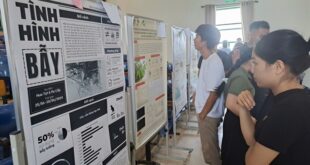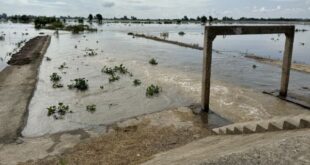
|
| Việt Nam will scale down the production and consumption of Hydrofluorocarbons. Photo congthuong.vn |
HÀ NỘI — Việt Nam will scale down production and consumption of Hydrofluorocarbons (HFCs) – powerful greenhouse gases which are the main drivers of climate change.
Under the roadmap to carry out the Montreal Protocol on the protection of the stratospheric ozone layer by phasing out ozone-depleting substances, Việt Nam will begin managing and eliminating all fluorinated chemicals from 2024, working toward reducing consumption by 10 per cent during 2029-2034, 30% during 2035-2039, 50 per cent during 2040-2044, and 80 per cent from 2045.
Việt Nam has proactively carried out the protocol and agreements that it has joined in, while aligning with international laws on regulations to improve state management over climate change and ozone layer protection.
In Decree No. 06/2022/ND-CP dated January 7, 2022, which details the reduction of greenhouse gas emissions and the protection of the ozone layer, the Government stipulates a roadmap to manage and phase out ozone-depleting substances, as well as management principles and coordination responsibilities among state-owned agencies.
Details to implement the law on environmental protection in response to climate change, with guidelines to use, collect, transport, recycle, reuse, and treat the substances were laid down in the Ministry of Natural Resources and Environment (MoNRE)’s Circular No. 01/2022/TT-BTNMT dated January 7, 2022.
The Government also issued Decree No. 45/2022/ND-CP on July 7, 2022, specifying penalties for administrative violations in the field of environment, including those on the use of substances controlled under the Montreal Protocol.
The Department of Climate Change under the MoNRE joined hands with the Việt Nam Society of Refrigeration and Air-conditioning Engineers and the Institute of Heat Engineering and Refrigeration to provide training for nearly 188 lecturers from colleges and vocational schools, and 3,068 technical staff from refrigeration equipment service and maintenance facilities nationwide.
A wide range of activities have been held to support the state management work, including developing standards for capacity assessment and certification for air-conditioning technicians. National standards limiting the use of flammable expansion agents in foam production, and the use of flammable refrigerants in air-conditioners are critical to reducing HFC use.
The Montreal Protocol was signed in 1987 and entered into force on January 1, 1989. It is an international treaty designed to protect the ozone layer by phasing out the production of numerous substances that are responsible for ozone depletion.
To date, it has been ratified by 197 countries, and has been one of the most successful environmental agreements to date. A united global effort to phase out ozone-depleting substances means that today, the hole in the ozone layer is healing, in turn protecting human health, economies, and ecosystems.
Việt Nam became a signatory of the United Nations Framework Convention on Climate Change in 1992, the Vienna Convention for the Protection of the Ozone Layer, and the Montreal Protocol in 1994. VNS
- Reduce Hair Loss with PURA D’OR Gold Label Shampoo
- Castor Oil Has Made a “Huge” Difference With Hair and Brow Growth
- Excessive hair loss in men: Signs of illness that cannot be subjective
- Dịch Vụ SEO Website ở Los Angeles, CA: đưa trang web doanh nghiệp bạn lên top Google
- Nails Salon Sierra Madre
 VnExpress News The News Gateway of Vietnam
VnExpress News The News Gateway of Vietnam





